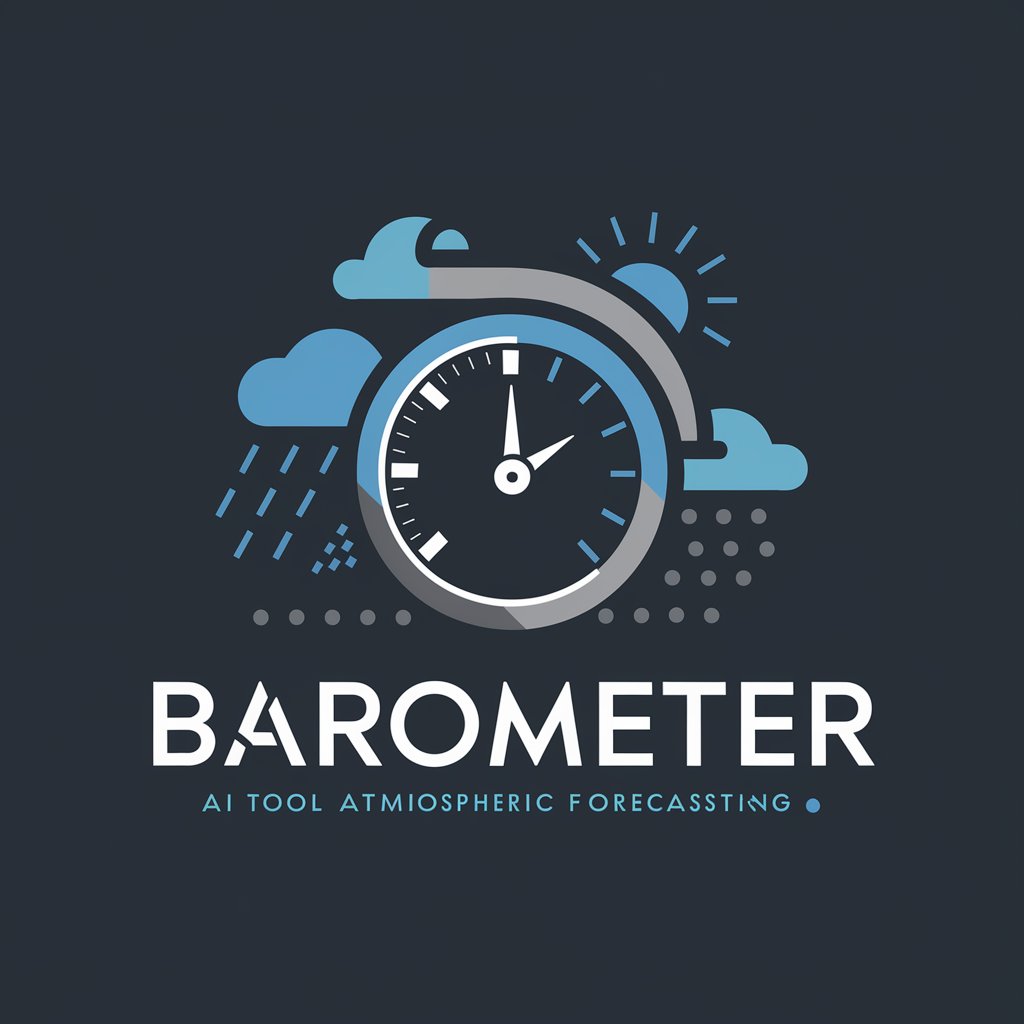Barometer - Atmospheric Pressure Tracking

Welcome! Let's explore the science of weather and atmospheric pressure.
Predict Weather with AI-Powered Precision
Explain how a barometer works in measuring atmospheric pressure.
Describe the role of barometers in weather forecasting.
What are the different types of barometers used in meteorology?
How does barometric pressure affect weather patterns?
Get Embed Code
Introduction to Barometer
A barometer is an instrument designed to measure atmospheric pressure, a fundamental parameter in meteorology and various scientific research fields. It operates based on the principle that the air above us exerts a weight, and changes in this weight (or pressure) can indicate shifts in weather patterns. The design and functionality of barometers have evolved from simple mercury-filled tubes in the 17th century to sophisticated electronic sensors today. For example, the mercury barometer, invented by Evangelista Torricelli in 1643, consists of a glass tube filled with mercury inverted into a mercury-filled basin. The height of the mercury column adjusts as atmospheric pressure changes, offering a direct measure of the pressure. Modern digital barometers use electronic sensors to detect pressure changes, translating these into precise numerical readings. These advancements enable accurate weather forecasting, navigation, and scientific research, illustrating the barometer's critical role in understanding and interacting with our environment. Powered by ChatGPT-4o。

Main Functions of Barometer
Weather Forecasting
Example
Predicting storm systems
Scenario
A falling barometer reading indicates an approaching low-pressure system, often associated with stormy weather. Meteorologists use this data to forecast storms, enabling early warnings and preparation.
Navigation
Example
Aiding in aircraft navigation
Scenario
Pilots use barometric readings to determine altitude, adjusting flight paths for safety and efficiency. Barometers in aircraft measure the pressure difference between the outside air and a known standard, providing accurate altitude readings.
Scientific Research
Example
Studying climate patterns
Scenario
Researchers monitor barometric pressure over time to identify climate trends and understand atmospheric dynamics. This data contributes to models predicting long-term climate changes and immediate weather phenomena.
Ideal Users of Barometer Services
Meteorologists
Experts in weather forecasting rely on barometric data to predict weather changes, storm systems, and atmospheric disturbances. The precision of barometric measurements is vital for their work in providing accurate forecasts and warnings to the public.
Pilots and Mariners
For those navigating the skies or seas, barometric readings are essential for determining altitude and sea level pressure, respectively. This information is crucial for safe travel, route planning, and weather anticipation.
Climate and Environmental Researchers
Scientists studying atmospheric science, climate change, and environmental patterns use barometers to gather data on pressure variations. This information helps in modeling climate systems and understanding environmental impacts on weather and climate.

How to Use Barometer
Start with a Free Trial
Begin by exploring yeschat.ai to access a free trial of Barometer without needing to log in or subscribe to ChatGPT Plus.
Understand the Basics
Familiarize yourself with how barometers measure atmospheric pressure and their importance in weather forecasting. This foundational knowledge will enhance your use of Barometer.
Monitor Atmospheric Pressure
Use Barometer to monitor current atmospheric pressure readings. This is crucial for predicting weather changes, such as approaching storms or fair weather.
Analyze Trends
Observe and analyze pressure trends over time. A steady decrease often indicates worsening weather conditions, while an increase suggests improving weather.
Apply to Daily Activities
Utilize the data from Barometer for various activities such as planning outdoor events, agricultural planning, and research projects to optimize decisions based on weather forecasts.
Try other advanced and practical GPTs
Stock Sentiment Analyzer
Empower Your Investments with AI-Driven Sentiment Analysis

Storybook GPT
Crafting tales with AI-powered imagination

Texto Persuasivo
Elevate Your Messages with AI

Mentor Matrix: Biblioteca Digital del Futuro
Empowering your learning journey with AI

Six Thinking Hats System
Harness AI to Empower Decision-Making

Meet your God
Divine wisdom tailored to your journey

AccessAid
Empowering Accessibility with AI

Instant SME
Empower conversations with AI-crafted expertise.

Powder Pal
Unlock the best snow with AI-powered insights.

HR Reporting Buddy
Empowering HR with AI-driven Insights

Recruiter Reporting Buddy
AI-powered Recruitment Insights

Transurfing GPT
Manifest Desires with AI-Powered Transurfing

Frequently Asked Questions about Barometer
What is a barometer?
A barometer is an instrument used to measure atmospheric pressure. It provides insights into weather conditions by indicating changes in pressure, allowing forecasts of weather changes.
How can Barometer aid in weather forecasting?
Barometer helps in weather forecasting by providing real-time data on atmospheric pressure. This data is crucial for predicting weather changes, such as storms, rainfall, or sunny days.
Can Barometer predict all types of weather changes?
While Barometer is effective in predicting many weather changes through atmospheric pressure readings, its accuracy might vary with sudden meteorological conditions and unforeseen variables.
Is Barometer useful for academic research?
Yes, Barometer is invaluable for academic research, particularly in fields related to meteorology, environmental science, and atmospheric studies, by providing precise atmospheric pressure data.
How does Barometer differ from traditional barometers?
Barometer, as a digital tool, offers more accessible and real-time atmospheric pressure readings compared to traditional, manual barometers. It also integrates with data analysis tools for comprehensive weather forecasting.
